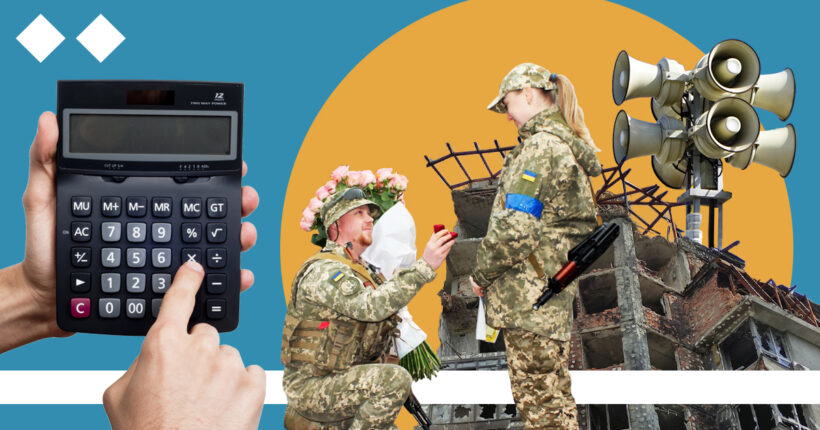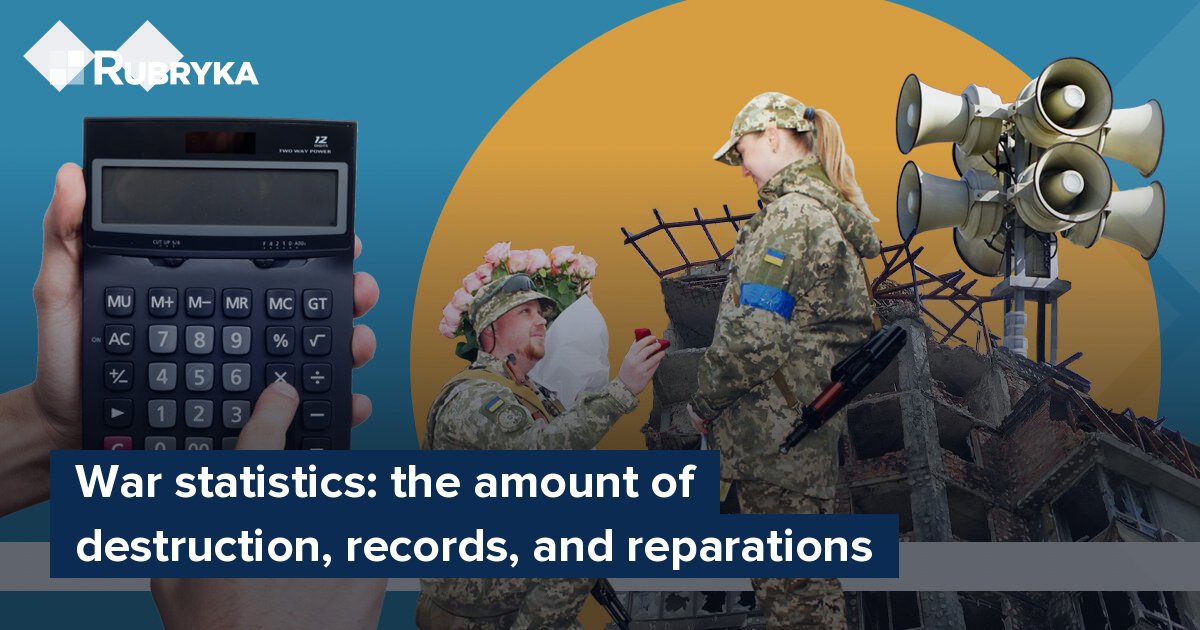
During the past year, the Armed Forces of Ukraine liberated an area almost the size of Switzerland
When russia invaded Ukraine on February 24, it openly revealed the bloody face of the aggressor to the whole world. The russian army began to advance through the territory of Ukraine with the intention of capturing all of its cities. They failed, but still managed to capture some of Ukraine's territory. The Armed Forces of Ukraine have succeeded in liberating 39,048 square kilometers of Ukraine's territory during the past year – an area almost the size of Switzerland. However, 106,825 square kilometers remain occupied.

The territory suffered terrible destruction: the russians caused damages amounting to $750 bln
According to the Ministry of the Environment, environmental damages total at least $441 bln, and Ukraine has begun to document at least $50.5 mln in reparations that russia should pay for the country's reconstruction.

The total amount of damage caused by russian aggression is hard to accurately measure — Denys Shmyhal, Ukraine's prime minister, estimated that the figure had already reached $600-750 bln by the beginning of 2023.
123,000 residential buildings destroyed
Ukraine's government reported that as of the beginning of 2023, about 123,000 residential buildings have been partially or entirely destroyed throughout Ukraine – 70% of them in frontline regions.
In 364 days, Ukrainians heard 16 670 air alarms
The Luhansk region is the record holder for the number of alarms — there were only 2 but the last one is still ongoing. It has been active for 328 days. The most peaceful region in Ukraine was the Zakarpattia region — with 230 alarms that lasted a total 11 days and 17 hours.

A total of 16,670 air alarms sounded in Ukraine.
Ukraine received more than 4,000 units of military equipment for the defense of its territory during the year
Bloomberg journalists, with the help of defense analysts Oryx, counted weapons and equipment sent to Ukraine and promised to be transferred soon.
Allies have provided Ukraine with at 4,000 pieces of equipment, including armored vehicles, artillery, aircraft, and other weapons to help Kyiv fight russia. NATO leaders have promised to send battle tanks, that are among the alliance's best weapons designed to destroy tanks and will help Ukraine in retaking occupied territories back from russian control.
Tanks and infantry fighting vehicles
- 410 Soviet-era tanks from NATO member states from the former communist bloc, including Poland, the Czech Republic, and Slovenia.
- More than 10 Challenger 2 tanks, which Britain has promised to provide in the near future.
- A company of Leopard 2 tanks from Poland is due to arrive soon.
- 300 armored infantry vehicles, including 250 BMPs of Soviet design from former communist countries.
- AMX-10RC wheeled tanks from France.
- The US and Germany said they would supply 50 Bradley combat vehicles and 40 Marder combat vehicles.
- During Joe Biden's visit to Kyiv, the American president said that the US had provided a total of 700 tanks to Ukraine during the past year of the war.
Armored personnel carriers
- A total of 1,100 armored personnel carriers, including 300 M113 and 250 M117 armored personnel carriers.
- More than 160 American-made M113s from seven other countries, including Great Britain, Lithuania, Australia, Germany, Denmark, Portugal, and Spain.
- Several hundred other vehicles, including armored medical vehicles.
- About 925 mine-protected vehicles (MRAPs), including 440 US M1224 MaxxPros.
- 90 Australian Bushmaster MRAPs and several British Wolfhounds and Mastiffs.
- Over 1,540 infantry vehicles, including 1,250 Humvees.
Artillery
- 300 towed howitzers, including over 210 155mm M777s and 72 US 105mm howitzers.
- More than 400 units of self-propelled artillery, including more than 20 155-mm howitzers from Great Britain and 18 each from Poland, Germany, and the USA.
Multiple rocket launchers
- A total of 95 MLRS, including 38 highly mobile artillery missile systems known as HIMARS, produced by the American company Lockheed Martin.
- More than 40 communist-era 122-mm multiple rocket launchers from Poland and the Czech Republic.
Anti-aircraft defense
- 37 German self-propelled Gepard units.
- 8 American-made NASAMS missile batteries.
- 1 American and 1 German Patriot missile battery.
- 6 Strela-10M missile systems from the Czech Republic.
- 6 Stormer HVMs from Great Britain.
- Several other anti-aircraft missile systems from Slovakia, Germany, Spain, France, and Poland.
Aviation
- 14 Su-25 attack aircraft were purchased in Bulgaria by NATO countries and delivered to Ukraine.
- 4 Su-25s from North Macedonia.
- 20 russian-made Mi-17 helicopters, initially intended for Afghanistan, were donated by the United States.
- 11 helicopters of Soviet design from the Czech Republic, Slovakia, and Latvia.
- Three British Westland Sea Kings helicopters.
- Six russian-made Ka helicopters from Portugal.
- Over 30 Bayraktar TB2 drones from Turkey, as well as one each from Lithuania and Poland.
- Hundreds of units of US Switchblade Barrage Ammunition.
- 415 reconnaissance drones.
Ukraine also received anti-radar missiles, radio-electronic warfare, unmanned watercraft, radar equipment, and other systems.
Bloomberg adds that these figures are approximate and cannot be independently verified. These may include items pledged but not delivered, and other items not included may have been delivered but not disclosed.
The Armed Forces of Ukraine doubled in size
In 2018 the ranks of the Armed Forces number was around 250,000. Since the beginning of the war, this number has increased significantly. Back in May, Zelensky said that 700,000 soldiers were fighting russia's armed aggression, so that Ukrainians could continue to to live free on their land and work for the return of the occupied territories.
Railways became the most popular means of transport in Ukraine and carried a record number of passengers
Since the beginning of the full-scale war with the russian federation, more than 14.5 million citizens have already left Ukraine, mostly to EU states.
In 2022, main Ukrainian railway operator Ukrzaliznytsia transported about 1.4 million passengers to EU states, marking a record for the last 10 years. Ukraine's national railway operator was a key part of the evacuation effort, bringing more than 600,000 people to safety in neighboring countries:
"Then the railway was the safest form of transport, and now it is the most convenient form of transport for traveling between home and place of temporary residence," said Oleksandr Kamyshin, chairman of the board of Ukrzaliznytsia, adding that the railway saw almost ten times as many travelers between Ukraine and Europe as the year before.
The route between Kyiv and Warsaw remains the most popular international train from Ukraine. Ukrzaliznytsia receives more than 2,000 requests to buy tickets for this route daily in its online services, but its capacity is limited to 150 seats per train.
Love is stronger than war: a "wedding boom"
Ukraine recorded 4% more marriages during the full-scale invasion than in 2021. Their number increased for the first time in the last three years, Opendatabot, a service for monitoring Ukrainian data of Ukrainian companies, combining data from open public registers and providing complete information about a person or company, reports.
A significant marriage boom occurred in Kirovohrad (6,473) and Poltava (10,610) regions. Over the year, newly-created families increased by 1.6 and 1.5 times, respectively. Most marriages were registered in the Dnipropetrovsk region, where 26,534 new families were formed; 43% more than in 2021.
30% fewer children were born than in peacetime in 2021
From February to December 2022, 30% fewer newborn children were registered than in 2021. This may be because some children were born abroad, and their birth has not yet been certified by Ukrainian state institutions.
In total, 195 thousand Ukrainians were born in 2022, 51.5% boys and 48.5% girls. The gender distribution is almost unchanged: 51.5% boys in 2022 versus 51.52% in 2021.
In the past year of the war, there were half as many divorces as in peacetime
According to open data recorded by Opendatabot, in 2020, the number of divorced couples was almost 10 times higher than before — 119,253 couples ended their marriages; in 2021, the number of divorces exceeded 29.5 thousand, and the year 2022 set a record in the lowest number of divorces, with only 17,893 couples ending their marriages.
The housing market has changed in a way we never expected: living in Transcarpathia is now more expensive than in the capital
According to real estate website domRIA housing prices in Kharkiv fell by half and in Kyiv by a third. But in Zakarpattia (also known as Transcarpathia), the most western region of Ukraine, housing prices increased by almost 200%.

The graph above shows statistics on the average prices of renting a one-bedroom apartment in different regions of Ukraine, with the highest prices in the western regions up to $470 and the lowest in the most war-affected areas in the east and south — about $80.
Prices for some products rose by a quarter on average
According to the State Statistics Service, inflation on the consumer market in January 2023 compared to January 2022 amounted to 26.0%. This means that goods from at grocery store increased in price by more than a quarter on average during the year of war.
Fruits and eggs changed the most, rising by 77% and 73%, respectively, followed by fish and fish products, which became the record-breakers in prices rising by almost half (inflation was 45.5%). The cost of clothing cost did not change much — prices increased only 0.7%.
In general, this result is better than the National Bank expected. According to their forecasts, inflation should have been 30%. At the same time, Deputy Chairman of the National Bank Serhii Nikolaychuk predicted that in 2023 inflation in Ukraine will gradually slow down, but will remain relatively high at about 20%.
GDP decreased by a third but gradually began to recover
According to the State Statistics Service, real GDP decreased by 30.8% compared to the third quarter of 2021. But towards the end of 2022, it gradually began to increase — in the third quarter of 2022, compared to the second quarter, it increased by 9.0%.
This may be because the register of large taxpayers has grown by 220 companies. This happened since twice as many new companies were added to the list as were removed: 397 new businesses versus 177 companies that dropped out. For comparison, in 2022, on the contrary, this list of large taxpayers was reduced by 32 companies.
Ukraine began to trade less with other countries
During the past year of the war, Ukraine traded with 230 countries, but both imports and exports decreased. In January-November 2022, the export of goods was $40,671.2 mln, or 66.4%. Compare that to January-November 2021, when imports totaled $49,194.9 mln, or 75.8%. The shrinking in foreign trade amounted to $8,523.7 mln, more than twice the change of the same period in 2021 ($3,635.3 mln).
The general dynamics of the economy also worsened. The export-import coverage ratio was 0.83. In January-November 2021, this ratio was higher — 0.94.
At the same time, Ukraine began to export more live animals and products of animal origin, as well as mineral fuels, oil, and petroleum products. There was little change in wood exports, as Ukraine exported 94% percent of the amount of wood in 2021.
Newsletter
Digest of the most interesting news: just about the main thing







